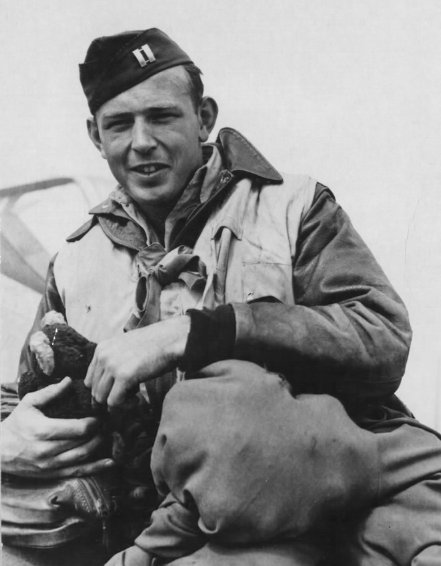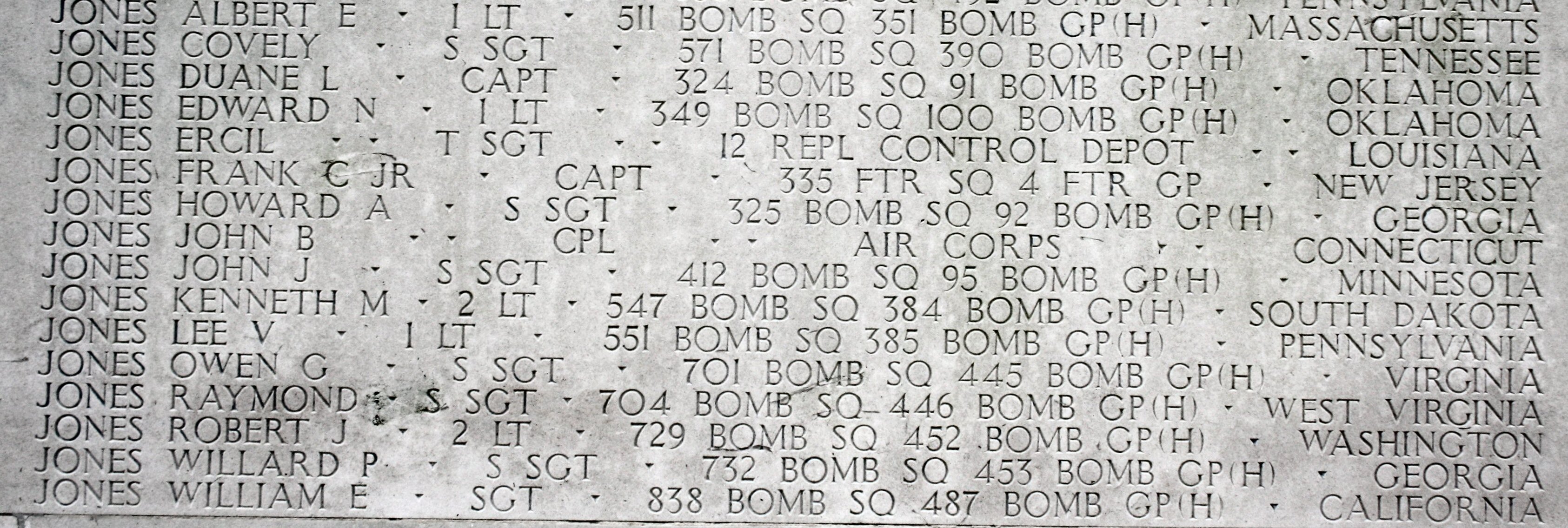The next eighteen months, Jones and his squadron spent in Iceland, stationed at an airfield near Reykjavik. Jones was promoted to First Lieutenant and was awarded the Air Medal. Then, in February, 1944, the squadron was transferred to England, leaving its planes in Iceland. While they were waiting for their new planes to arrive, Jones happened to meet J. A. Clark, Jr., then a Major in the famous "Eagle Squadron" of the R.A.F. which, renamed, had become part of the 8th Air Force on America's entry into the war, and with Clark's assistance succeeded in transferring to the latter squadron, flying P-51's.
On his first combat mission with his new outfit, Jones, according to American newspaper reports, dove five miles through the air to shoot down his first German plane. This was only the beginning of a brilliant career as a fighter pilot. Newspaper reports vary slightly as to the number of enemy planes destroyed by Jones, but he has been credited in some of them with 7-1/2% shot down from the air, 7 destroyed on the ground, all in the space of little more than two months, during which time he was awarded four Clusters to his Air Medal, was given the Distinguished Flying Cross, recommended for a Cluster to the Distinguished Flying Cross, promoted to Captain and made Deputy Squadron Commander.
In July, he participated in the first shuttle bombing of Germany, from England to Russia to Italy to England-with a raid from Italy over Roumania, where he shot down two German planes.
On August 8th, Jones went on what was to have been his last combat mission before a 30-day leave. A German convoy off Stavenga on its way down the coast of Norway was to be attacked. In the fighting that took place, Jones' plane was apparently hit by antiaircraft fire. The War Department reported that it had been seen to enter the water about twenty miles off Stavenga and that in a reconnaissance of this area afterwards a parachute had been seen floating in the water not far from where the plane went down. Jones was at first listed as missing in action. On November 4th, he was stated by the War Department to be reported killed in action August 8th.
Very rugged and dependable under pressure with a great amount of fortitude,-as he disappeared from his squadron with glycol pouring from the engine of his badly damaged plane, Jones radioed Lieutenant Russell, a fellow pilot, to tell his fiancee that he would see her after the war. He and Miss Elizabeth Konantz had become engaged while he was in England, and were to have been married in his thirty-day leave following the mission to Norway.
The only son of Mr. and Mrs. F. C. Jones, Frank Jones is also survived by his sister, Miss Helen Jones.
The next eighteen months, Jones and his squadron spent in Iceland, stationed at an airfield near Reykjavik. Jones was promoted to First Lieutenant and was awarded the Air Medal. Then, in February, 1944, the squadron was transferred to England, leaving its planes in Iceland. While they were waiting for their new planes to arrive, Jones happened to meet J. A. Clark, Jr., then a Major in the famous "Eagle Squadron" of the R.A.F. which, renamed, had become part of the 8th Air Force on America's entry into the war, and with Clark's assistance succeeded in transferring to the latter squadron, flying P-51's.
On his first combat mission with his new outfit, Jones, according to American newspaper reports, dove five miles through the air to shoot down his first German plane. This was only the beginning of a brilliant career as a fighter pilot. Newspaper reports vary slightly as to the number of enemy planes destroyed by Jones, but he has been credited in some of them with 7-1/2% shot down from the air, 7 destroyed on the ground, all in the space of little more than two months, during which time he was awarded four Clusters to his Air Medal, was given the Distinguished Flying Cross, recommended for a Cluster to the Distinguished Flying Cross, promoted to Captain and made Deputy Squadron Commander.
In July, he participated in the first shuttle bombing of Germany, from England to Russia to Italy to England-with a raid from Italy over Roumania, where he shot down two German planes.
On August 8th, Jones went on what was to have been his last combat mission before a 30-day leave. A German convoy off Stavenga on its way down the coast of Norway was to be attacked. In the fighting that took place, Jones' plane was apparently hit by antiaircraft fire. The War Department reported that it had been seen to enter the water about twenty miles off Stavenga and that in a reconnaissance of this area afterwards a parachute had been seen floating in the water not far from where the plane went down. Jones was at first listed as missing in action. On November 4th, he was stated by the War Department to be reported killed in action August 8th.
Very rugged and dependable under pressure with a great amount of fortitude,-as he disappeared from his squadron with glycol pouring from the engine of his badly damaged plane, Jones radioed Lieutenant Russell, a fellow pilot, to tell his fiancee that he would see her after the war. He and Miss Elizabeth Konantz had become engaged while he was in England, and were to have been married in his thirty-day leave following the mission to Norway.
The only son of Mr. and Mrs. F. C. Jones, Frank Jones is also survived by his sister, Miss Helen Jones.
Bio by: Athanatos
Gravesite Details
Entered the service from New Jersey.
Family Members
Sponsored by Ancestry
Advertisement
Records on Ancestry
Sponsored by Ancestry
Advertisement







